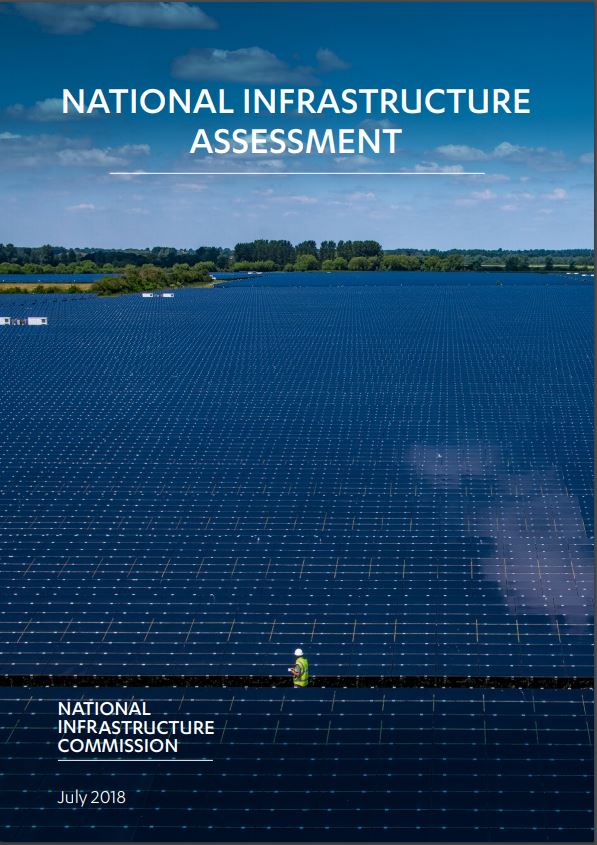UK government wants 'full fibre' for everyone by 2033, while the country tumbles down the broadband speed table


Solar panels dominate the cover of the NIC report on the UK's infrastructure.
The British government's National Infrastructure Commission published a 160-page report yesterday (July 10) covering the health of the nation's cities, the future of its roads, making the switch to low-carbon energy and, among other things, the need to improve broadband communications.
The report proposes that "the government devise a National Broadband Plan by Spring 2019, to deliver full fibre connections across the whole of the country, including those in rural areas - this should ensure that the technology is available to 15 million homes and businesses by 2025, 25 million by 2030, and all homes and businesses by 2033."
This is, obviously, a very long time. However, the UK has a mediocre track record when it comes to FTTP (Fibre to the Premises). Some countries have already reached 40 per cent coverage while the UK, at the last count, hadn't passed the one percent level needed to make the FTTH Council Europe comparison table.
It should not surprise anyone that the latest report on worldwide broadband speeds from Cable.co.uk - which was also in the news today - showed the UK dropping four places to 35th in a table of 200 countries. Users in table-topping Singapore had average speeds of 60.39Mbps, followed by Sweden, Denmark, Norway and Romania.
UK users averaged only 18.57Mbps.
The speed data is compiled by M-Lab, a partnership whose members include Princeton University's PlanetLab, Google Open Source Research, and the New America Foundation's Open Technology Institute.
Other European countries are already investing in better broadband, so the M-Lab report suggests that the UK will fall even further behind next year.
In this respect, the NIC's recommendations are just not pushy enough. The chancellor, Philip Hammond, had already floated the idea in a speech to the CBI's annual dinner on May 22. "I am now setting a new target to see full-fibre to the premises connections being available to 15 million premises, that's the majority of homes and businesses, by 2025," said Hammond, "and we'll go further, by committing to finish the job - and deliver a nationwide full-fibre to the premises network by 2033."
The NIC report suggests that the UK can do the job thanks to competition plus public subsidies like the ones behind the BDUK project. But the majority of the work was done by BT's Openreach division, and sometimes it was the only bidder.
Laying fibre to rural areas is expensive, and it's hard work. The NIC is correct to point out that in villages where it doesn't make economic sense to lay fibre, companies are not going to compete to lose even more money. Government support will be required.
While companies other than BT often boast about the number of premises that they will be able to serve with high-speed broadband, they're less keen to point out that they are very often the same premises. Someone in a London suburb - me, for example - can already get Virgin Media (average speed of 362Mbps), EE's Unlimited Fibre Max 1 Broadband (145Mbps), BT Superfast Fibre 2 (67Mbps), and 63Mbps services from TalkTalk, Vodafone, and Sky. I'll be amazed if I can't get several 300Mbps or faster services before many rural areas reach double figures - unless there's a significant push into 4G or 5G cellular broadband.
The speed at which countries can roll out fibre is limited by "backhoe time" - the necessity to dig up roads and pavements, which often involves delays working with local authorities. This is why small city-states like Singapore are hard to beat. However, it can still be done. It just requires the political will, and money.
Back in March, the UK's spring budget included a derisory £95 million investment in fibre broadband for selected areas. As I pointed out at the time, this contrasts with the British government spending vast sums on white elephants such as the HS2 rail link to Birmingham (£55.7bn), the Hinkley Point C nuclear power station (£18bn), and four Trident submarines (£31bn). You can probably add the third runway at Heathrow to the list.
When it comes to FTTH/B (fibre to the home or building), the UK isn't just a long way behind countries such as Romania (35 percent), Bulgaria (28 percent) and Kazakhstan (15 percent), it's behind Trinidad and Tobago (17 percent), Puerto Rico (3.6 percent) and Jordan (1.1 percent).
The NIC report says: "In the past, the UK had the ambition and foresight to connect the whole country to electricity, water and transport networks. The benefits today are obvious. The same ambition is needed now for digital infrastructure."